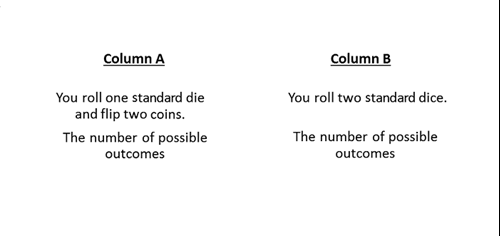What is the SCAT for Intermediate Students?
The School and College Ability Test (SCAT) Intermediate level is a critical assessment designed specifically for academically gifted 4th and 5th grade students. This above-grade-level test serves as the gateway to the prestigious Johns Hopkins Center for Talented Youth (CTY) program and other gifted education opportunities.
Free SCAT Intermediate Test Practice Questions
SCAT Intermediate Practice Test for the 4th & 5th Grade
To do as well as possible on the SCAT, your child must be as prepared as possible. Ideal preparation consists of study guides based on the material, plenty of practice questions, and a simulated testing environment.
TestPrep-Online currently offers child-friendly SCAT Practice Test packs for your 4th or 5th grader. Each pack comes with questions based on specific sections, and detailed explanations to follow. Plus, with our online accessibility, you can practice anytime, anywhere!
Expert Sample Questions with Tutor Insights
Verbal reasoning questions all have the same instruction
Each question begins with two words. These two words go together in a certain way. Under them, there are four other pairs of words lettered A, B, C, and D.
SCAT Verbal Reasoning Sample Question 1- Intermediate Level
Find the lettered pair of words that go together in the same way as the first pair of words.
dilemma : difficult ::
TestPrep-Online Tutor's Tip:
"I always tell my students to define the relationship in their own words first. Here, a dilemma IS difficult by nature. Look for the answer where the first word IS the second word inherently. 'Reek' means to smell unpleasant, making D correct. Avoid trap answers like A, where 'enigma' is the opposite of 'clear.'"
SCAT Verbal Reasoning Sample Question 2- Intermediate Level
Find the lettered pair of words that go together in the same way as the first pair of words.
composer : symphony ::
TestPrep-Online Tutor's Tip:
"When I see creator-to-creation relationships, I ask: 'What does this person make from scratch?' A composer creates a complete symphony. An author creates a complete novel. Notice how A is tempting, but a blueprint isn't the finished building—it's just the plan. Always go for the finished product!"
SCAT Verbal Reasoning Sample Question 3- Intermediate Level
Find the lettered pair of words that go together in the same way as the first pair of words.
obsolete : antiquated ::
TestPrep-Online Tutor's Tip:
"For synonym relationships, I teach students to substitute one word for the other in a sentence. 'That phone is obsolete' works the same as 'That phone is antiquated.' Try this with the answer choices—only D works: 'The glass is transparent' has nearly the same meaning as 'The glass is translucent.'"
SCAT Intermediate Practice Pack
Complete preparation tailored for 4th & 5th graders
Quantitative reasoning questions all have the same instruction.
Each of the following questions has two parts. One part is in Column A. The other part is in Column B.
You must find out if one part is greater than the other or if the parts are equal.
Then, choose one of the four answers below:
A if the part in Column A is greater
B if the part in Column B is greater
C if the two parts are equal
D if not enough information is given for you to decide
SCAT Quantitative Reasoning Sample Question 1- Intermediate Level
Which column is bigger?

TestPrep-Online Tutor's Tip:
"I teach my students to calculate step-by-step and avoid mental shortcuts that lead to errors. Column A: 3/4 × 28 = 21. Column B: 2/3 × 30 = 20. Always double-check your arithmetic—one small mistake changes everything. Column A is greater, so the answer is A."
SCAT Quantitative Reasoning Sample Question 2- Intermediate Level
| Column A | Column B |
| 3/4 of 28 | 2/3 of 30 |
Choose one of the four answers below:
TestPrep-Online Tutor's Tip:
"With variables, I always test specific values to see the pattern. Try n=1: Column A becomes 5, Column B becomes 6. Try n=2: Column A becomes 7, Column B becomes 7. Try n=3: Column A becomes 9, Column B becomes 8. Since the relationship changes based on n's value, the answer is D—not enough information."
SCAT Quantitative Reasoning Sample Question 3- Intermediate Level
| Column A | Column B |
| n is a positive number 2n + 3 | n + 5 |
Choose one of the four answers below:
TestPrep-Online Tutor's Tip:
"For geometry problems, I train students to use estimation strategically. Don't just guess—use what you know about shapes, angles, and proportions. If exact calculation isn't possible, systematic estimation often leads to the right answer. Look for visual clues that give away the relationship."
Boost your Child's Intermediate SCAT Scores!
Explore our SCAT Practice Packs with Tests, Quizzes and Expert Tips
About the 4th-5th Grade Intermediate SCAT
4th and 5th grade students take the Intermediate SCAT Test, an above-grade-level-test, in order to gain admissions to the Johns Hopkins Center for Talented Youth (CTY) program. The SCAT scores of 4th graders are compared to a general 6th grade level and the scores of 5th graders are compared to a general 8th grade level. For more information, check out SCAT Registration FAQs.
Benefits:
- Strategic preparation for middle school advanced courses
- Positions students for honors and advanced track in high school
- Develops critical thinking and problem-solving skills
- Encourages academic ambition and goal-setting
- Helps identify specific academic strengths to nurture
SCAT Intermediate Format & Content
Intermediate SCAT:
- Target Grades: Students currently in grades 4 and 5.
- Content Difficulty: The questions are typically based on material found in grades 6-8 curricula.
- Verbal: Vocabulary becomes more complex, and the relationships in the analogies can be more subtle or abstract.
- Quantitative: Includes more complex arithmetic, fractions, decimals, percentages, introductory algebra concepts, more advanced geometry, and data analysis.
As in the case of both the Elementary and Advanced SCAT Tests, the Intermediate SCAT is made out of two sections- verbal and quantitative reasoning. Each section has 55 multiple-choice questions, five of which are experimental. Students must complete each section within a time frame of 22 minutes for each portion, and a 10-minute break in the middle.
The Intermediate SCAT builds upon the foundation assessed in the Elementary SCAT, introducing more challenging content and expecting a higher level of cognitive reasoning appropriate for the older age group. The use of different test levels ensures that the assessment is tailored to the developmental stage and academic knowledge of the students being evaluated.
10 Prepping Tips for the SCAT Intermediate Test
Preparing for any gifted children test can be daunting. Luckily, TestPrep-Online is here to help! Here are ten tips for both you and your child to help lead you in the right direction:
- Provide a tangible goal. Sometimes, when a difficult task is before you, it’s hard to see the endpoint, let alone stay positive about it. This is true for everyone, but especially young children. Don’t forget to remind your child why you’re doing this. Remember to add an element to your reminder that can motivate them as well.
- Consult the instructors. No one knows your child’s academic abilities better than his or her teachers. Take the time to book a meeting with your child’s math and English instructors to get a feel for where his or her strengths lie. By taking their input into consideration, you will be able to better understand how to structure your study plan, and where to put your greatest efforts.
- Keep your studying limits reasonable. Some topics may take more time than others. As a result, you may find yourself taking a longer time working on them. While this is a logical approach, keep in mind that covering everything might not always be possible. Instead, give yourself a limit to how much time you give each topic.
- Eat right, sleep right. No matter how organized your study schedule is or how clear your goals are, none of the benefits will show if your child can’t properly process the information. Don’t forget to make sure your child is getting the right sources of energy to carry out the studying necessary to succeed. Remember to include nutritious snacks (examples include nuts, fruits, and unprocessed foods), as well as a proper sleep schedule (the recommended amount of time is 9-11 hours).
- Have fun. Unfortunately, boredom is the cousin of pattern and routine. To avoid this detrimental side effect, your child will need something fun to remain focused and excited to learn. Don’t be afraid to make things more entertaining by adding interactive activities into your studying routine, and maybe even prizes. Baking, sports, and scavenger hunts are some of the many activities you can choose from.
- Encourage question asking. A great way to keep your child active in the learning process is to encourage plenty of question asking. This will motivate him or her to pay attention, as s/he will have to find topics to ask about.
- Keep it varied. Remember to vary both studying locations and material. Many recommend not studying a topic for more than two hours at a time
- Take breaks. Regular breaks are an essential tool for ensuring optimal performance. Breaks have been shown to improve focus and information absorption.
- Practice with practice tests. To really help your child become accustomed to the testing format, we suggest utilizing practice tests. Arguably the most important tip for practicing for an exam, this method will both familiarize your child with the format of the test and decrease the likelihood of testing anxiety. You can even start today! Try TestPrep-Online's Free Intermediate SCAT Sample Questions.
Family Membership - Best Value!
Full access to ALL test prep materials for one year
Looking for a different SCAT Practice Pack? Check out our other products!
Not sure about our products? Try some free sample questions!
Frequently Asked Questions
Most students benefit from 6-8 weeks of consistent preparation, studying 30-45 minutes per day, 4-5 days per week.
Intermediate SCAT targets 4th-5th graders with 6th-8th grade content, while Elementary targets 2nd-3rd graders with 4th-6th grade material.
Requirements vary by program, but generally students need to score at the 95th percentile or higher compared to their grade-level peers.



